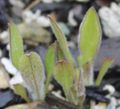Gaillardia aristata
- Latin Name: Gaillardia aristata
- Family: Asteraceae
- Common Names: blanket flower, great flowered gaillardia
- Codon: GALARI
Contents
Taxonomy
Description
Native, herbaceous taprooted perennial, with one or several stems rising from the base.[1] 1-3 dms tall.[2]
Leaves are alternate, rough-hairy, lance-shaped, entired to lobed, rarely pinnately divided.[1]
Capitate inflorescence bearing yellow rays, often maroon at base, 1.5-3.5 cm. long, disk corollas purplish. Receptacle concex to subglobose, with chaffy bristles that do not subtend the individual florets. [3]
Aristata derived from Latin arist, bristle, in reference to the hairy stems and leaves, and the bristled fruits.[1]
Fruit is a one-seeded, gray-brown achene, 7-10mm inch long, with densely ascending hairs, a short pappus crown 7-10mm long, and awns approximately two times as long as the fruit body.[1]
Bloom Period
May - September[4]
Distribution
From south-central Canada to southern Colorado, east to the Dakotas and west to the Cascade Mountains of Washington and the Blue Mountains of Oregon.[1]
Habitat
Sunny, well-drained sites in prairie meadows up to montane grassy openings.[2]
Uses
Medicine and Food
A rich array of medicinal uses, including but not limited to the following
Sx̌ʷyʔiɬpx use of whole plant decoction as a tonic for kidney ailments, poultice of plant applied for backaches, decoction of plant for headaches.[5]
Nlaka'pamux use of infusion of whole plant as a treatment for cancer. [6] It is important to note that depending on the time of the source and the orientation of the researcher, the term 'cancer' in medical and ethnobotanical texts may refer to a variety of conditions, that may or may not overlap neatly with common contemporary usage of the word.
Nlaka'pamux use of decoction of plant as a tuberculosis remedy.[6]
Havsuw' Baaja use as food, seeds parched, ground, and kneaded into seed butter.[7]
A rash or irritation may result from contact with the sap.[2]
Ecological
G. aristata can be used in producing native wildflower sod for restoration of native plant colonies.[1]
Provides food source of pollen, nectar, and cover for a wide variety of pollinators. It is a common nectar source for the adult stage of the butterfly, Edwards fritillary, Speyeria edwards. [1]
A cryptic moth, Schinia masoni, is color-camouflaged to mimic the yellow ray flowers and purplish-brown disk flowers of blanketflower as protection against predators.[1]
Forage for young sage-grouse.[1]
Competes well with certain noxious weeds such as Acroptilon repens.[1]
Propagation
Tolerant of drought conditions, and relatively fire resistant.[1]
May be grown from seed or crown division. Spring seeding is preferred over summer or fall dormant seeding. Stratification is not necessary, but a period of cold moist stratification may decrease germination variability. The plants tend to be rather long-lived and may re-seed once established. [2]
Photo Gallery
References
- ↑ 1.00 1.01 1.02 1.03 1.04 1.05 1.06 1.07 1.08 1.09 1.10 Winslow, S., 2011. Plant Guide for blanketflower (Gaillardia aristata). USDA-Natural Resources Conservation Service, Plant Materials Center. Bridger, Montana 59014.
- ↑ 2.0 2.1 2.2 2.3 Winslow, S. 2011. Plant fact sheet for blanketflower (Gaillardia aristata). USDA-Natural Resources Conservation Service, Plant Materials Center. Bridger, MT, 59014.
- ↑ Hitchcock, C. L., Cronquist, A., Giblin, D., & Legler, B. et al. (2018). Flora of the Pacific Northwest: an illustrated manual. Seattle: University of Washington Press.
- ↑ WTU Herbarium, Burke Museum, & University of Washington. Retrieved from https://biology.burke.washington.edu/herbarium/imagecollection/taxon.php?Taxon=Gaillardia%20aristata
- ↑ Native American Ethnobotany Database. Retrieved from http://naeb.brit.org/uses/search/?string=gaillardia+
- ↑ 6.0 6.1 Turner, Nancy J., Laurence C. Thompson and M. Terry Thompson et al., 1990, Thompson Ethnobotany: Knowledge and Usage of Plants by the Thompson Indians of British Columbia, Victoria. Royal British Columbia Museum, page 181. Retrieved from http://naeb.brit.org/uses/search/?string=gaillardia+
- ↑ Weber, Steven A. and P. David Seaman, 1985, Havasupai Habitat: A. F. Whiting's Ethnography of a Traditional Indian Culture, Tucson. The University of Arizona Press, page 67. Retrieved from http://naeb.brit.org/uses/search/?string=gaillardia+





